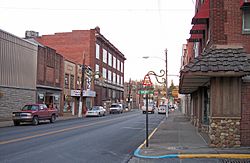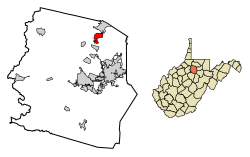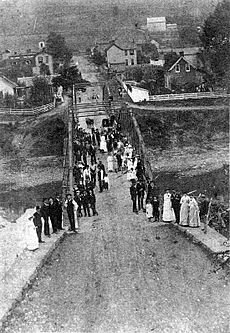Shinnston, West Virginia facts for kids
Quick facts for kids
Shinnston, West Virginia
|
|
|---|---|

Pike Street (U.S. Route 19) in downtown Shinnston in 2006
|
|

Location of Shinnston in Harrison County, West Virginia
|
|
| Country | United States |
| State | West Virginia |
| County | Harrison |
| Government | |
| • Type | Manager Plan |
| Area | |
| • Total | 1.67 sq mi (4.33 km2) |
| • Land | 1.67 sq mi (4.33 km2) |
| • Water | 0.00 sq mi (0.00 km2) |
| Elevation | 928 ft (283 m) |
| Population
(2020)
|
|
| • Total | 2,332 |
| • Estimate
(2021)
|
2,306 |
| • Density | 1,258.37/sq mi (485.98/km2) |
| Time zone | UTC-5 (Eastern (EST)) |
| • Summer (DST) | UTC-4 (EDT) |
| ZIP code |
26431
|
| Area code(s) | 304 |
| FIPS code | 54-73636 |
| GNIS feature ID | 1555613 |
Shinnston is a city in Harrison County, West Virginia, located along the West Fork River. It was once a busy coal town. In 1778, a man named Levi Shinn built his log home here. This house is now the oldest building still standing in north-central West Virginia. According to the 2020 census, about 2,332 people live in Shinnston.
Contents
Shinnston's Story: A Look at Its History
The story of Shinnston began in 1778 when Levi Shinn built his log house. This historic home is located along Route 19. It is the oldest building in the North Central West Virginia area. The Shinnston Historical Association takes care of it. Sometimes, you can even take a tour inside!
How Shinnston Became a Town
In 1815, the town was planned out with three streets running next to the river. Four other streets crossed them at right angles. Shinnston was officially made a town in 1852. Back then, it was called Shinn's Town. This happened when West Virginia was still part of Virginia. Solomon S. Fleming was chosen as the first mayor.
The town's name changed to Shinnston in 1877. In 1915, Shinnston started using a Mayor-Council government. This means a mayor and a group of council members ran the city. This system lasted for over 70 years. In 1998, people voted to change it. They decided to use a City Manager-Council government instead. This new system started on July 1, 1998, and is still used today.
Shinnston's Economy and Growth
Shinnston has always been a place with lots of business. It started with mills that processed grain and cut wood. Early businesses included a place to make leather (a tannery) and shops for wagon makers. There was also an undertaker, general stores, a pottery, and a local newspaper.
The railroad arrived in 1890, making it easier to transport goods. The first bank opened in 1899. From 1906 to 1947, a trolley system helped people get around. Like many places in West Virginia, energy has been very important. By the early 1900s, oil and gas wells joined coal as major industries. Today, energy production still provides many jobs. The city's economy has also grown to include more service businesses.
Community Life: Churches and Schools
Shinnston has a rich culture with many different faiths. The first church group started in 1786. They met in homes until their first church building was built in 1835. Churches in the area have even formed a Council of Churches. This group offers shared services for members of different faiths.
The first school in Shinnston opened in 1813 in a small log cabin. In 1860, a larger building was built. It served as a town hall and an academy (a type of school). This became the first public school in 1865. The first grade school opened in 1895. Shinnston High School was added in 1907. In 1978, Shinnston High School joined with Lumberport High School to create Lincoln High School.
Facing Challenges: The Shinnston Tornado
Over the years, Shinnston has faced natural disasters. The most famous was the Shinnston tornado. It hit on June 23, 1944, at 8:30 p.m. This was the deadliest tornado in West Virginia's history. Sixty-six people died in Shinnston and the surrounding areas. In total, 103 people were killed by the tornado, and 430 were seriously hurt.
The tornado caused a lot of damage to homes and buildings. Power lines went down, and hospitals had to use candles and flashlights. Phone service was quickly fixed thanks to emergency plans. Many people helped each other. A traveling circus even lent generators to the hospitals. People from all walks of life, including officials, police, and everyday citizens, worked together to help.
The Shinnston Tornado was part of a larger group of storms. These storms hit the northern Appalachian region in June 1944. Tornadoes were reported in Pennsylvania, Maryland, and West Virginia. The Shinnston Tornado was the strongest and most damaging. Tornadoes are rare in West Virginia. The Shinnston Tornado was an F-4 tornado. This means it had winds faster than 206 miles per hour. Such strong winds can destroy houses and even throw cars.
Shinnston During the Civil War
During the Civil War, the people in Shinnston mostly supported the Union (the North). Many local men joined the Union Army. In 1863, Confederate soldiers raided Shinnston during the Jones-Imboden raids.
Important Historical Landmarks
- The Levi Shinn's log house was built in 1778. The area was named after him. It was added to the National Register of Historic Places in 1973.
- The Shinnston Historic District was also added to the National Register of Historic Places in 1998.
Geography: Where is Shinnston?
Shinnston is located in the northern part of Harrison County. Its coordinates are 39°23′39″N 80°18′1″W / 39.39417°N 80.30028°W. The city covers a total area of about 1.73 square miles (4.48 square kilometers). All of this area is land.
Population: How Many People Live Here?
| Historical population | |||
|---|---|---|---|
| Census | Pop. | %± | |
| 1880 | 289 | — | |
| 1890 | 403 | 39.4% | |
| 1900 | 535 | 32.8% | |
| 1910 | 1,224 | 128.8% | |
| 1920 | 1,679 | 37.2% | |
| 1930 | 2,802 | 66.9% | |
| 1940 | 2,817 | 0.5% | |
| 1950 | 2,793 | −0.9% | |
| 1960 | 2,724 | −2.5% | |
| 1970 | 2,576 | −5.4% | |
| 1980 | 3,059 | 18.8% | |
| 1990 | 2,543 | −16.9% | |
| 2000 | 2,295 | −9.8% | |
| 2010 | 2,201 | −4.1% | |
| 2020 | 2,332 | 6.0% | |
| 2021 (est.) | 2,306 | 4.8% | |
| U.S. Decennial Census | |||
As of the 2020 census, Shinnston had a population of 2,332 people. In 2010, there were 2,201 people living in the city. This means the population has grown slightly. The population density was about 1,272 people per square mile. This tells you how many people live in each square mile of the city.
Arts and Culture: What to See and Do
Shinnston has several places and groups that celebrate arts and culture:
- Shinnston Community Band: This band started in 1996. It is a well-known community concert band in North Central West Virginia.
- Wind Down Wednesday: A local event.
- The Levi Shinn log house: This is the oldest standing building in North Central West Virginia. It is over 229 years old and is sometimes open for tours.
- Ferguson Memorial Park: A park for the community to enjoy.
- West Fork River trail: A trail along the river.
- Bice-Ferguson Memorial Museum: A museum to learn about local history.
- Clay District Veterans Memorial: A memorial honoring veterans.
- Lincoln High School: The local high school.
- Frontier Days Festival: A local festival.
Transportation: Getting Around Shinnston
Several important roads pass through Shinnston:
Notable People from Shinnston
Many interesting people have come from Shinnston, including:
- Frank Abruzzino, a football player
- Dick Brown, a baseball catcher
- Larry Brown, a baseball infielder
- Lee King, a baseball outfielder
- John McKay, a famous football coach
- Josh Richards, a race car driver
- Clay Riley, a state delegate
- Joe Stydahar, a football player in the Pro Football Hall of Fame
Shinnston in Books
Shinnston has even appeared in literature! Author Granville Davisson Hall wrote about a Shinnston tavern in his 1899 novel, Daughter of the Elm. Also, local author Meredith Sue Willis has used her memories of Shinnston in her novels.
See also
 In Spanish: Shinnston para niños
In Spanish: Shinnston para niños


